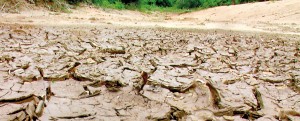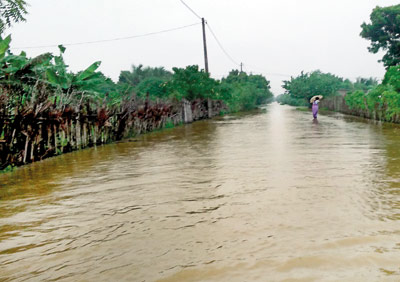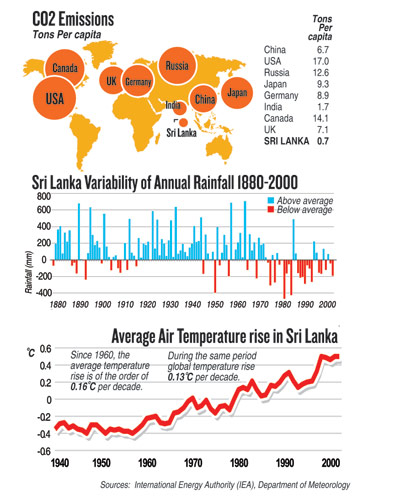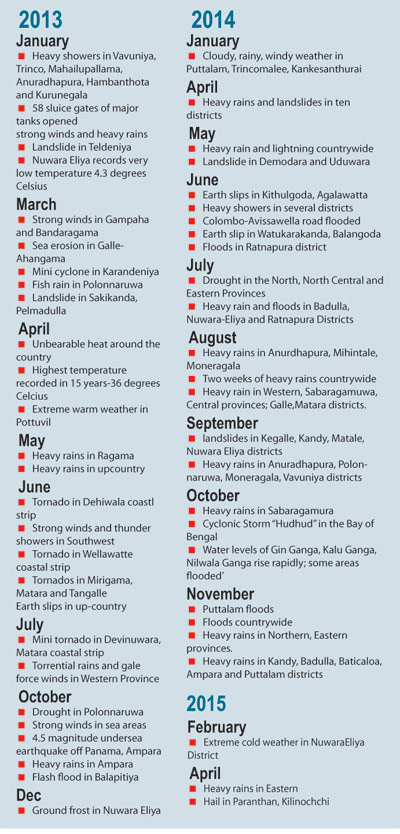News
Climate change has come to stay, Earth getting warmer
Last week, it rained so hard in Mannar that the rain gauge notched 350mm (12 inches) within a day. The waterways overflowed. It was a downpour of tremendous proportions. But, beset like the rest of the world by climate change problems, it was hardly unusual for Sri Lanka.
There is no sugarcoating it. Sri Lanka faces issues due to global warming. The most notable one is a change in rainfall patterns. There were more floods and more droughts. And each episode was more severe than the one before it.
Fifty years ago, rainfall of 80mm an hour was considered “extremely heavy”, said Lalith Chandrapala, Director General of Meteorology. Today, it was not unusual for there to be downpours of 120-140mm each time it rains.
The Met Department had analysed climate data since the 1880s and found that temperatures have risen. During the last five years, the rate of increase in Sri Lanka was about 0.016 degrees Celsius per year. This is about 0.2 degrees per decade.
“The rate of increase is very close to the global average,” Mr. Chandrapala observed. “If carbon dioxide concentrations in the atmosphere increase at the same rate, we can expect similar statistics in the future.” The Met Department is monitoring the weather patterns but needs a stronger means of gathering and analysing data.
“What we are witnessing now is intense rain that causes flash floods,” said P. Hettiarachchi, Director of Irrigation (Hydrology) Irrigation Department. “The intense rain is due to climate change; but its impact is high because of human activities. People have cleared forests and started building houses very close to rivers.”
“Earlier, we predicted rainfall in two monsoons—North-east and South-west,” he said. “Now, we have rain at unexpected times, in addition to the monsoons. With intense rain, reservoirs cannot retain water because they were not designed to hold that volume.”
And, yet, there is also drought; a near constant water shortage in the dry zone resulting in agriculture being crippled in those parts. This sector now needs to develop and introduce varieties of crops that are able to withstand extremes of weather.
Everything is interconnected. There is cause and effect. When the temperature increases, evaporation of water also rises. This affects reservoirs and there is less water for irrigation.
There is flooding in urban areas because the drainage systems are designed for 80mm of rain. It usually pours well in excess of that.
Sri Lanka has the additional problem of heavily silted reservoirs and agricultural tanks. Capacities are reduced to about 50-60 per cent of their original.
To blame is soil erosion caused by heavy rainfall. Mr. Chandrapala said 60 percent of the central highlands of the country was eroded.
On the pollution front, however, Sri Lanka has not done badly. Carbon dioxide emissions were “minuscule” compared to other countries. Chandrapala held.
Developing countries continued to pollute the atmosphere and propel their development by burning cheap fossil fuels.
World Bank statistics show that, in 2011, Sri Lanka’s carbon dioxide emissions were 0.73 metric tons per capita, while India’s emissions were 1.66 metric tons, the Maldives’ 3.26 metric tons and Pakistan’s 0.94 metric tons. Alarmingly, China emits 6.71 metric tons per capita.
In Sri Lanka, the sea level has gone up by 17cm. within the last 100 years, said Prof. Mohan Munasinghe, the Vice Chair of the UN Intergovernmental Panel on Climate Change.
He confirmed that dry areas of the country have become drier and wet areas wetter, leading to floods in some areas and drought in others.
In the hotter areas mosquitoes will be more rampant, he warned. They will even move into hilly areas. Thus, incidence of vector-borne diseases like malaria and dengue could increase in addition to diseases triggered by poor quality water that accompanies droughts.
Rural areas are expected to experience major impacts on water availability and supply. Prof. Munasinghe said climate change impacts are projected to slow down economic growth; make poverty reduction more difficult; further erode food security; and prolong existing and create new, poverty traps, particularly in urban areas and emerging hotspots of hunger.
The poor usually suffer most because they often live in heavily exposed regions, have limited ways to protect their livelihoods and face brutal challenges in the wake of natural disasters, Prof. Munasinghe said.
Water resources were of paramount importance to the economy and for livelihood. They played a pivotal role in eliminating poverty. Malnutrition and health problems are major issues threatening underprivileged countries. If sustainable development is to be achieved, these problems should be addressed.
Climate change was happening because of human interference, Prof. Munasinghe stressed. Over 95 per cent of it is caused by human activities, such as the burning of fossil fuels and the conversion of land for forestry and agriculture. Since the beginning of the Industrial Revolution, these human influences on the climate system have increased substantially.
The dominant product of fossil fuel combustion is carbon dioxide, a greenhouse gas. Higher concentrations of carbon dioxide and other greenhouse gases in the atmosphere cause the earth to warm.
Carbon dioxide is the main cause of human-induced climate change, the Professor explained. It has been emitted in vast quantities from the burning of fossil fuels and it is a very long-lived gas, which means it continues to affect the climate system during its long residence time in the atmosphere.
Sea levels can rise in two ways to climate change. First, as the oceans warm up due to increasing global temperature, sea water expands, taking up more space in the ocean basinand causing a rise in water levels. The second is the melting ice, which adds water to the ocean.
A small rise in the sea level will affect many people. There is an increased risk of coastal flooding, coastal storms and associated storm surges.
Even though an increase of a few degrees in global average temperature does not sound like much, global average temperature during the last Ice Age was only about 4 to 5 °C (7 to 9 °F) less than now.
Global warming of just a few degrees will be associated with widespread changes in regional and local temperatures and precipitation, as well as with increases in some types of extreme weather events.
Menake Wijesinghe, Senior Manager in Climate Change Adaptation at Janathakshan (GTE) Ltd., said that as the frequency of events like droughts increase, crop yields would decrease.
Developing countries use a large quantity of water for agriculture, while less water is used for the industrial sector. As a result of inadequate water, food production has declined considerably in developing countries.
Adaptation strategies are short and long-term changes to human activities that counter the effects of changes in climate, he said.
In agriculture, adaptation will require cost-effective investments in water infrastructure, emergency preparation for and response to extreme weather events, development of resilient crop varieties that tolerate temperature and precipitation stresses, and new or improved land use and management practices.

